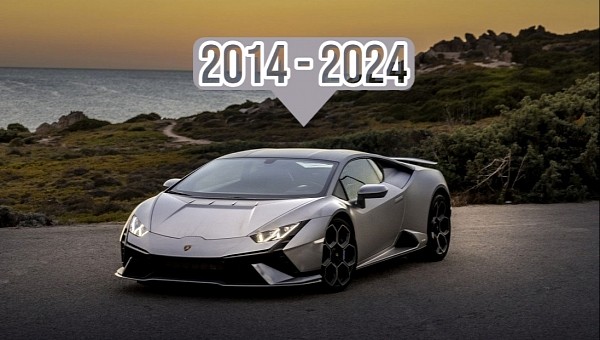Then owned by Chrysler, the Raging Bull of Sant’Agata Bolognese developed a 4.0-liter V10 in the late 1980s for the P140 mid-engine supercar. Only four prototypes were produced. Lamborghini tried to roll out an entry-level model in the 1990s with the Cala, once again, powered by the 4.0-liter V10 of its predecessor. That didn’t work out under Megatech’s ownership, though.
Lamborghini was eventually sold to the Volkswagen Group in 1998. The German automaker decided on producing a ten-cylinder replacement for the V8-engined Jalpa, introduced in 2003 in the form of the Gallardo.
Soon joined by a technically similar model from Audi, the Gallardo would be upgraded from 5.0 to 5.2 liters. The odd-firing V10 would carry over to the Huracan, which is due to be replaced in late 2024 for MY2025.
Chief executive officer Stefan Winkelmann confirmed the successor during a recent presentation. The big kahuna didn’t share any in-depth information on the yet-to-be-named successor, which is likely to enter production after the Huracan Sterrato finishes its run.
The all-road supercar will number 1,499 units. Lamborghini Ad Personam offers a whopping 350 exterior colors and more than 60 colors for the interior upholstery. The starting price of the jacked-up Huracan is €263,000 in Europe, which converts to $277,570.
In regard to what’s going to replace the highly successful Huracan, the peeps at Road & Track cite a Motor Trend report on a hybridized twin-turbo V8 powertrain. We first heard that hybridization is a given back in 2017, when Stefano Domenicali was running Lamborghini.
Last year, Stephan Winkelmann refused to confirm the number of cylinders hiding under the hood. On the upside, Winkelmann did mention that it’s a brand-new engine that has nothing in common with the twin-turbo V8 in the Urus and naturally-aspirated V12 in the Aventador.
The Urus will soon receive a plug-in hybrid V8 option, whereas the now-discontinued Aventador will pass the torch to a 1,001-horsepower flagship later this month. The newcomer combines a V12 of the naturally aspirated variety with no fewer than three electric drive units, with one of them integrated into the new dual-clutch tranny.
Chief technical officer Rouven Mohr confirmed plug-in hybrid assistance for the Huracan’s replacement as well, aligning the “baby Lambo” with the Aventador’s replacement. He also let it slip that it’s packing between six and twelve cylinders, leaving the door open for the naturally-aspirated V10 introduced so many years ago.
The V10 isn’t likely to survive past 2024, though. Audi will soon pull the plug on the R8, with its heir apparent reportedly going electric. The naturally-aspirated V10 is expected to be replaced by a twin-turbo V8 whose turbochargers reportedly kick in at 7,000 revolutions per minute. It’s also rumored to redline at 10,000 revolutions per minute, which is astounding for a twin-turbo lump.
In combination with plug-in hybrid assistance, the Huracan’s long-awaited successor will be more than capable of showing the Ferrari 296 series a thing or two in a straight line. As a brief refresher, the V6-powered 296 produces a simply insane 819 ponies on full song.
Soon joined by a technically similar model from Audi, the Gallardo would be upgraded from 5.0 to 5.2 liters. The odd-firing V10 would carry over to the Huracan, which is due to be replaced in late 2024 for MY2025.
Chief executive officer Stefan Winkelmann confirmed the successor during a recent presentation. The big kahuna didn’t share any in-depth information on the yet-to-be-named successor, which is likely to enter production after the Huracan Sterrato finishes its run.
The all-road supercar will number 1,499 units. Lamborghini Ad Personam offers a whopping 350 exterior colors and more than 60 colors for the interior upholstery. The starting price of the jacked-up Huracan is €263,000 in Europe, which converts to $277,570.
In regard to what’s going to replace the highly successful Huracan, the peeps at Road & Track cite a Motor Trend report on a hybridized twin-turbo V8 powertrain. We first heard that hybridization is a given back in 2017, when Stefano Domenicali was running Lamborghini.
Last year, Stephan Winkelmann refused to confirm the number of cylinders hiding under the hood. On the upside, Winkelmann did mention that it’s a brand-new engine that has nothing in common with the twin-turbo V8 in the Urus and naturally-aspirated V12 in the Aventador.
The Urus will soon receive a plug-in hybrid V8 option, whereas the now-discontinued Aventador will pass the torch to a 1,001-horsepower flagship later this month. The newcomer combines a V12 of the naturally aspirated variety with no fewer than three electric drive units, with one of them integrated into the new dual-clutch tranny.
Chief technical officer Rouven Mohr confirmed plug-in hybrid assistance for the Huracan’s replacement as well, aligning the “baby Lambo” with the Aventador’s replacement. He also let it slip that it’s packing between six and twelve cylinders, leaving the door open for the naturally-aspirated V10 introduced so many years ago.
The V10 isn’t likely to survive past 2024, though. Audi will soon pull the plug on the R8, with its heir apparent reportedly going electric. The naturally-aspirated V10 is expected to be replaced by a twin-turbo V8 whose turbochargers reportedly kick in at 7,000 revolutions per minute. It’s also rumored to redline at 10,000 revolutions per minute, which is astounding for a twin-turbo lump.
In combination with plug-in hybrid assistance, the Huracan’s long-awaited successor will be more than capable of showing the Ferrari 296 series a thing or two in a straight line. As a brief refresher, the V6-powered 296 produces a simply insane 819 ponies on full song.



























